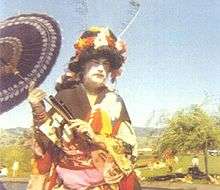Hibiscus (entertainer)
Hibiscus (born George Edgerly Harris III; September 6, 1949 – May 6, 1982) was an American actor and performance artist. He was the founder of the psychedelic gay liberation theater collective known as the Cockettes in early 1970s San Francisco.
Hibiscus | |
|---|---|
 Hibiscus as Madame Butterfly at Sonoma State University in 1970 | |
| Born | George Edgerly Harris III September 6, 1949 Bronxville, New York, U.S. |
| Died | May 6, 1982 (aged 32) New York City, U.S. |
| Occupation |
|
Early life
Harris was born in Bronxville, New York in 1949 to George Harris II and Ann M. Harris. The family moved to Clearwater Beach, Florida. The Harris parents became interested in theater and began performing with a local community theater called "The Little Theater". George and his siblings started a children's theater troupe, the El Dorado Players. In 1964, the family moved to New York, and Harris appeared in commercials, television, and in 1966 in an Off Broadway play titled Peace Creeps by John Wolfson with Al Pacino and James Earl Jones.[1]
In 1967, George Harris III and his father George Harris II appeared in New York in the Off-Off-Broadway play Gorilla Queen by Ronald Tavel.[2]
War protest
Hibiscus (then George Harris) joined the October 21, 1967 anti-war march on the Pentagon (in order to "levitate" it) and appears in the historic photograph of that event, Flower Power; he was the turtleneck sweater-wearing protester photographed putting flowers into the gun barrels of the MPs.[3]
Bernie Boston, the photographer, recalled the moment in a 2005 Curio Magazine (James Madison University) interview with Alice Ashe.[4] He said: "When I saw the sea of demonstrators, I knew something had to happen. I saw the troops march down into the sea of people, and I was ready for it." One soldier lost his rifle. Another lost his helmet. The rest had their guns pointed out into the crowd, when all of a sudden a young hippie stepped out in front of the action with a bunch of flowers in his left hand. With his right hand he began placing the flowers into the barrels of the soldiers' guns. Said Boston, "He came out of nowhere and it took me years to find out who he was … his name was Harris."
The Cockettes
Hibiscus, whose full beard, vintage dresses, make-up and costume jewelry created a defiant look, even by later standards, embraced drag and drugs as paths to spiritual liberation, and attracted a group of like-minded hippies who loved show-tunes, dressing up, showing off and dropping acid, and became The Cockettes.
The Cockettes decked themselves out in drag outfits and glitter for a series of legendary midnight musicals at the Palace Theater in San Francisco's California North Beach neighborhood. They quickly became a "must-see" for San Francisco's gay community, with their outlandishly decadent productions like "Journey to the Center of Uranus," "Tinsel Tarts in a Hot Coma" and "Gone with the Showboat to Oklahoma."[5] Two notable Cockettes were the disco diva darling Sylvester and the "queen of B-movie filth" Divine, who sang "If there's a crab on Uranus you know you've been loved" while dressed as a psychedelic crab queen.
When the Cockettes wanted to start charging for their shows, Hibiscus left, believing all shows should be free, and formed the Angels of Light in San Francisco, which gave many free theatrical performances in the early 1970s in San Francisco and New York City.[6] After moving back to New York, he put together a number of off-off Broadway revues, of which Sky High ran the longest. He also appeared in a daytime soap opera under his birth name. In the early 1980s, he and his sisters Jayne Anne, Eloise and Mary Lou and brother Fred, formed the glitter rock group "Hibiscus and the Screaming Violets," supported by musicians Ray Ploutz on bass, Bill Davis on guitar and Michael Pedulla on drums.
Hibiscus died of Kaposi's sarcoma due to complications from AIDS on May 6, 1982 at St. Vincent's Hospital in New York City.[7] He was an early AIDS casualty; at the time of his death the new illness was still referred to as GRID.[8]
References
- Silva, Horacio (2003-08-17). "Karma Chameleon". New York Times. Retrieved 2011-01-14.
- Poland, Albert (1972). The off, off Broadway book: the plays, people, theatre. Bobbs-Merrill. p. 199.
- Flowers, Guns and an Iconic Snapshot, The Washington Post, retrieved 22 Nov, 2007
- "Bernie Boston: View Finder" (PDF). jmu.edu. 2005. Archived from the original on September 20, 2009. Retrieved September 29, 2017.CS1 maint: BOT: original-url status unknown (link)
- www.cockettes.com History, retrieved 22 Nov 2007 Archived 2009-08-06 at the Wayback Machine
- Waxman, D.J. (1981-06-01), "New Waves or Perennial Blossoms: D.J. Waxman Meets Hibiscus", New York Native
- "Cockettes founder Hibiscus dies in New York; 300 other cases reported; Kaposi research hurt by cutbacks". Body Politic (85). Toronto. July–August 1982. p. 16.
- "Founder of Cockettes, Hibiscus, Dead of GRID", Advocate (345): 12, June 1982